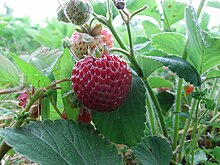Kitty Schindler
Mieze Schindler (also raspberry strawberry ) is a variety of garden strawberry ( Fragaria × ananassa ). Otto Schindler from Pillnitz bred them in 1925 from the Lucida Perfecta and Johannes Müller varieties and named them after his wife.
The plants of this variety grow moderately strong, they form quite flat, loose clumps. The runnings are strong. The leaves are dark green in color. The flowers appear mid-early and stand above the foliage.
The variety only produces medium-sized fruits in relatively small numbers. The good aroma is reminiscent of that of forest strawberries , although the proportion of sweetness is significantly higher. On the outside, the fruits are dark red with clearly recessed nuts, while the flesh is pink on the inside. Because of its sensitivity to pressure, the berry cannot be stored well and is rarely grown commercially.
There is a lower yield per plant than newer varieties because of the number and size of the fruits, and the susceptibility to diseases such as fruit and leaf rot is higher. In addition to these disadvantages, which make commercial use difficult, the variety has another specialty. To pollinate the flowers, she still needs a pollinator variety so that the exclusively female flowers develop fruiting bodies. In the past, the Senga Sengana variety has proven to be a good choice because the flowering period must match. Varieties such as Tenira , Korona and Ostara are also suitable. One of the named pollinator varieties should be planted for every three to five plants of the Mieze Schindler variety .
A self-pollinating variety derived from Mieze Schindler is available in stores under the Mieze Nova HZ variety name.
supporting documents
- Manfred Fischer (Ed.): Color Atlas of Fruit Types . 2nd Edition. Eugen Ulmer, Stuttgart 2003, ISBN 3-8001-5547-8 , pp. 238 .
